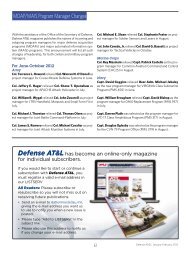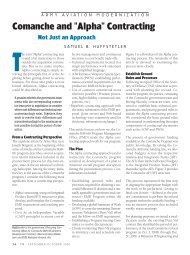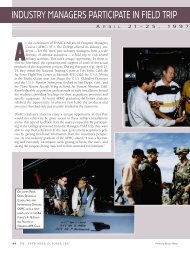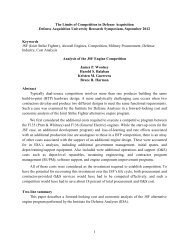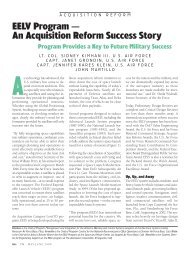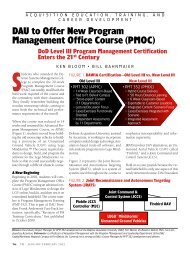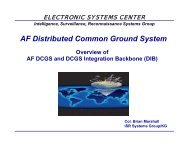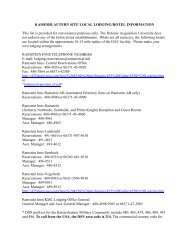Defense ARJ - Defense Acquisition University
Defense ARJ - Defense Acquisition University
Defense ARJ - Defense Acquisition University
Create successful ePaper yourself
Turn your PDF publications into a flip-book with our unique Google optimized e-Paper software.
�<br />
�<br />
�<br />
�<br />
�<br />
�<br />
�<br />
systeM DoD WeaPon of systeMs DeVeloPMent<br />
ProGraMs<br />
Prompt and high-volume global strike to deter aggression or coercion and, if<br />
deterrence fails, to provide a broader range of conventional response options<br />
to the President. This will require broader authorities from the Congress.<br />
Secure broadband communications into denied or contested areas to support<br />
penetrating surveillance and strike systems.<br />
Integrated defenses against short-, intermediate-, and intercontinental-range<br />
ballistic and cruise missile systems.<br />
Air dominance capabilities to defeat advanced threats.<br />
Undersea warfare capabilities to exploit stealth and enhance deterrence.<br />
Capabilities to shape and defend cyberspace.<br />
Joint command and control capabilities that are survivable in the face of<br />
WMD-, electronic-, or cyber-attacks (DoD, 2006).<br />
The 2001 QDR called for improved effectiveness and efficiency in moving and<br />
sustaining military forces in distant theaters, which included efforts to have a quicker<br />
deployment process and reduce the logistics footprint and its associated costs. The<br />
2006 QDR called for examining supply chain logistics costs by showing the relationship<br />
between resources and supply chain logistics to better understand the costs they<br />
incur. Also, it called for continuous performance improvement. For example, DoD<br />
uses Radio Frequency Identification (RFID) to carry out logistics support through<br />
automated asset visibility and management. The RFID allows for the sharing, integration,<br />
and synchronizing of data from the strategic to the tactical level, which shows<br />
the cause-and-effect relationship between resources and readiness. Using RFID<br />
and implementing Lean Six Sigma and performance-based logistics will markedly<br />
improve DoD’s supply chain (DoD, 2006).<br />
To improve sustainment capability by achieving an integrated joint force that<br />
is more agile and more rapidly deployable with a reduced logistics footprint, DoD<br />
adopted the Future Logistics Enterprise (FLE). It serves as a near-term logistics blueprint<br />
to strengthen the warfighter from 2005 to 2010 through end-to-end customer<br />
service and enterprise integration into the 21st century (FLE, n.d.).<br />
The FLE has six interrelated initiatives to meet the requirements of the QDR and<br />
the National <strong>Defense</strong> Strategy.<br />
Depot Maintenance Partnership. Depot maintenance services cost over $17<br />
billion annually. The purpose of this initiative is to increase partnerships with the<br />
commercial sector. Due to national security, DoD will continue to retain depot maintenance<br />
capability, but will encourage increased private sector investment in depot<br />
infrastructure, better facility and equipment management, and better depot business<br />
practices (FLE, n.d.).<br />
Condition-Based Maintenance Plus (CBM+). Currently, DoD is unable to predict<br />
equipment failures in their maintenance programs, resulting in excessive supply<br />
197



